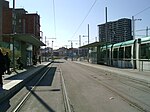Real Club de Polo de Barcelona
1897 establishments in CataloniaCatalan building and structure stubsCatalan field hockey clubsCatalan sport stubsField hockey clubs established in 1897 ... and 9 more
Olympic equestrian venuesOlympic modern pentathlon venuesPolo clubsReal Club de Polo de BarcelonaSpanish sports venue stubsSports clubs in BarcelonaSports venues in BarcelonaSummer Olympic venue stubsVenues of the 1992 Summer Olympics
Real Club de Polo de Barcelona (English: Barcelona Royal Polo Club) is a sports venue in Barcelona, Spain. Established in 1897, it had 9000 members at the time of the 1992 Summer Olympics. Normally used for polo, field hockey, tennis, squash, and swimming by its members, the club was the venue for the Olympic equestrian competition (dressage, jumping, and the eventing finals) and the riding portion of the modern pentathlon events.
Excerpt from the Wikipedia article Real Club de Polo de Barcelona (License: CC BY-SA 3.0, Authors).Real Club de Polo de Barcelona
Avinguda d'Albert Bastardas, Barcelona
Geographical coordinates (GPS) Address Website External links Nearby Places Show on map
Geographical coordinates (GPS)
| Latitude | Longitude |
|---|---|
| N 41.3818 ° | E 2.1111 ° |
Address
Real Club de Polo de Barcelona
Avinguda d'Albert Bastardas
08001 Barcelona (Districte V)
Catalonia, Spain
Open on Google Maps




